完整版2018年湖北高考英语试题及答案
- 格式:doc
- 大小:34.88 KB
- 文档页数:12
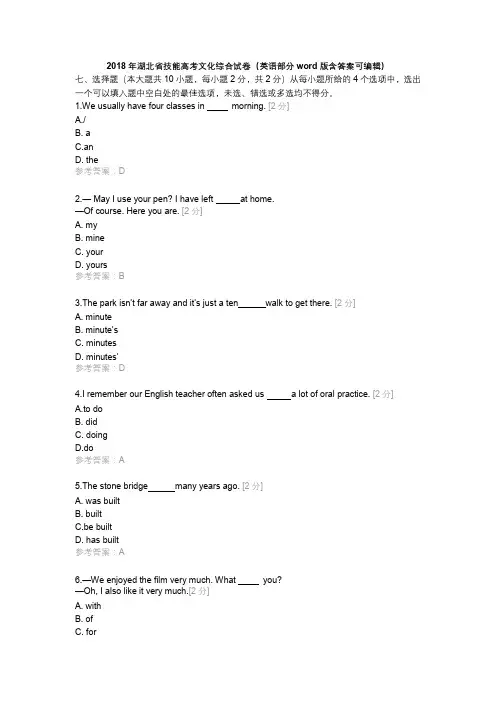
2018年湖北省技能高考文化综合试卷(英语部分word版含答案可编辑)七、选择题(本大题共10小题,每小题2分,共2分)从每小题所给的4个选项中,选出一个可以填入题中空白处的最佳选项,未选、错选或多选均不得分。
1.We usually have four classes in morning. [2分]A./B. aC.anD. the参考答案:D2.— May I use your pen? I have left at home.—Of course. Here you are. [2分]A. myB. mineC. yourD. yours参考答案:B3.The park isn’t far away and it’s just a ten walk to get there. [2分]A. minuteB. minute’sC. minutesD. minutes’参考答案:D4.I remember our English teacher often asked us a lot of oral practice. [2分]A.to doB. didC. doingD.do参考答案:A5.The stone bridge many years ago. [2分]A. was builtB. builtC.be builtD. has built参考答案:A6.—We enjoyed the film very much. What you?—Oh, I also like it very much.[2分]A. withB. ofC. forD. about参考答案:D7.He has made much progress and makes mistakes in his homework than before.[2分]A. fewB. feverC. manyD. more参考答案:B8.It’s noisy outside. Let’s go and see is happening. [2分]A. whatB. whichC. thatD. who参考答案:A9.He is tallest boy in the class. [2分]A. thirdB. threeC. the thirdD. the three参考答案:C10.—It is a lovely day,?—Yes. Shall we go out for a walk? [2分]A.is itB. isn’t itC. does itD. doesn’t it参考答案:B二、阅读理解(本大题共5小题,每小题2分,共10分)阅读下列短文,短文后面有5个小题,从每小题所给的四个选项中,选出最佳答案,未选、错选或多选均不得分。
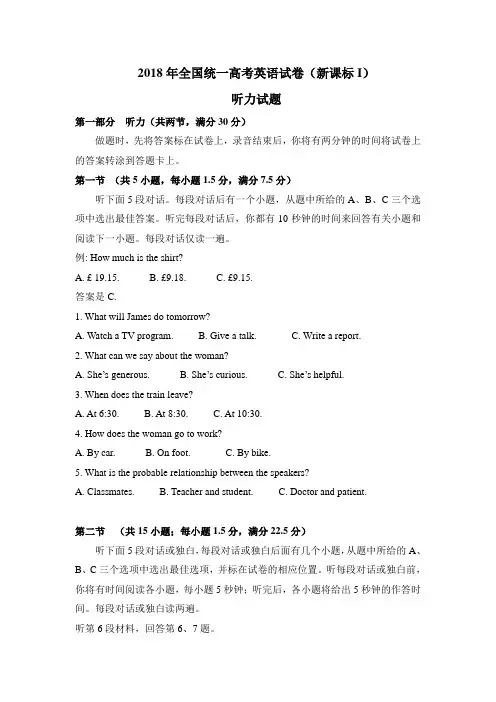
2018年全国统一高考英语试卷(新课标I)听力试题第一部分听力(共两节,满分30分)做题时,先将答案标在试卷上,录音结束后,你将有两分钟的时间将试卷上的答案转涂到答题卡上。
第一节(共5小题,每小题1.5分,满分7.5分)听下面5段对话。
每段对话后有一个小题,从题中所给的A、B、C三个选项中选出最佳答案。
听完每段对话后,你都有10秒钟的时间来回答有关小题和阅读下一小题。
每段对话仅读一遍。
例: How much is the shirt?A. £ 19.15.B. £9.18.C. £9.15.答案是C.1. What will James do tomorrow?A. Watch a TV program.B. Give a talk.C. Write a report.2. What can we say about the woman?A. She’s generous.B. She’s curious.C. She’s helpful.3. When does the train leave?A. At 6:30.B. At 8:30.C. At 10:30.4. How does the woman go to work?A. By car.B. On foot.C. By bike.5. What is the probable relationship between the speakers?A. Classmates.B. Teacher and student.C. Doctor and patient.第二节(共15小题;每小题1.5分,满分22.5分)听下面5段对话或独白,每段对话或独白后面有几个小题,从题中所给的A、B、C三个选项中选出最佳选项,并标在试卷的相应位置。
听每段对话或独白前,你将有时间阅读各小题,每小题5秒钟;听完后,各小题将给出5秒钟的作答时间。
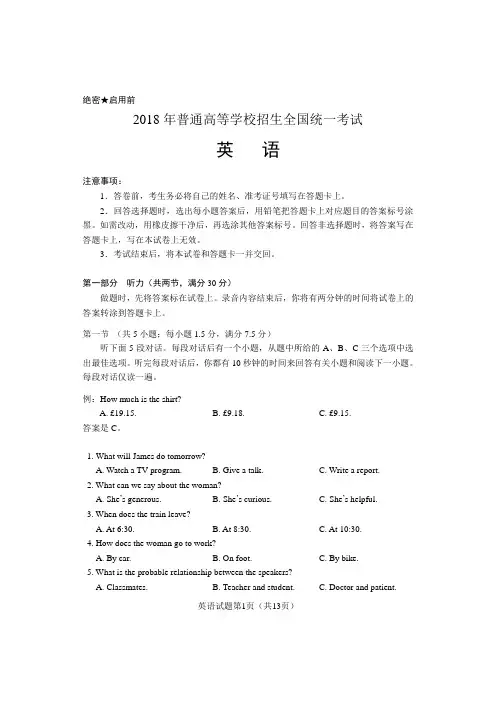
绝密★启用前2018年普通高等学校招生全国统一考试英语注意事项:1.答卷前,考生务必将自己的姓名、准考证号填写在答题卡上。
2.回答选择题时,选出每小题答案后,用铅笔把答题卡上对应题目的答案标号涂黑。
如需改动,用橡皮擦干净后,再选涂其他答案标号。
回答非选择题时,将答案写在答题卡上,写在本试卷上无效。
3.考试结束后,将本试卷和答题卡一并交回。
第一部分听力(共两节,满分30分)做题时,先将答案标在试卷上。
录音内容结束后,你将有两分钟的时间将试卷上的答案转涂到答题卡上。
第一节(共5小题;每小题1.5分,满分7.5分)听下面5段对话。
每段对话后有一个小题,从题中所给的A、B、C三个选项中选出最佳选项。
听完每段对话后,你都有10秒钟的时间来回答有关小题和阅读下一小题。
每段对话仅读一遍。
例:How much is the shirt?A. £19.15.B. £9.18.C. £9.15.答案是C。
1. What will James do tomorrow?A. Watch a TV program.B. Give a talk.C. Write a report.2. What can we say about the woman?A. She’s generous.B. She’s curious.C. She’s helpful.3. When does the train leave?A. At 6:30.B. At 8:30.C. At 10:30.4. How does the woman go to work?A. By car.B. On foot.C. By bike.5. What is the probable relationship between the speakers?A. Classmates.B. Teacher and student.C. Doctor and patient.英语试题第1页(共13页)第二节(共15小题;每小题1.5分,满分22.5分)听下面5段对话或独白。
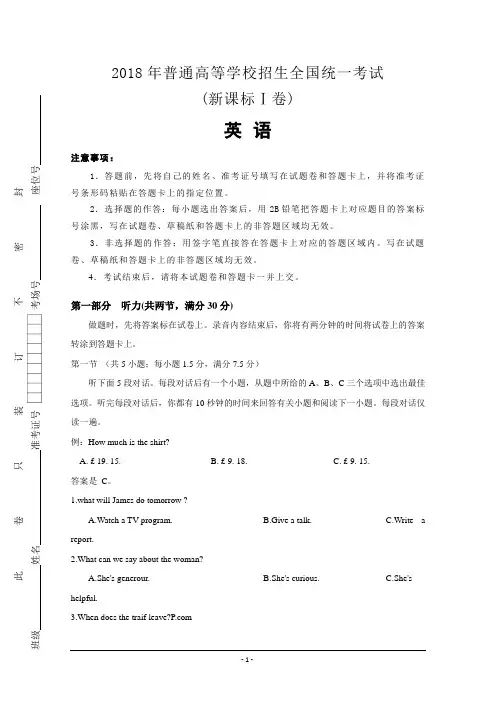
2018年普通高等学校招生全国统一考试(新课标Ⅰ卷)英 语注意事项:1.答题前,先将自己的姓名、准考证号填写在试题卷和答题卡上,并将准考证号条形码粘贴在答题卡上的指定位置。
2.选择题的作答:每小题选出答案后,用2B 铅笔把答题卡上对应题目的答案标号涂黑,写在试题卷、草稿纸和答题卡上的非答题区域均无效。
3.非选择题的作答:用签字笔直接答在答题卡上对应的答题区域内。
写在试题卷、草稿纸和答题卡上的非答题区域均无效。
4.考试结束后,请将本试题卷和答题卡一并上交。
第一部分 听力(共两节,满分30分)做题时,先将答案标在试卷上。
录音内容结束后,你将有两分钟的时间将试卷上的答案转涂到答题卡上。
第一节 (共5小题;每小题1.5分,满分7.5分)听下面5段对话。
每段对话后有一个小题,从题中所给的A 、B 、C 三个选项中选出最佳选项。
听完每段对话后,你都有10秒钟的时间来回答有关小题和阅读下一小题。
每段对话仅读一遍。
例:How much is the shirt? A. £ 19. 15.B. £ 9. 18.C. £ 9. 15.答案是 C 。
1.what will James do tomorrow ?A.Watch a TV program.B.Give a talk.C.Write areport.2.What can we say about the woman?A.She's generour.B.She's curious.C.She'shelpful.3.When does the traif leave?此卷只装订不密封级 姓名 准考证号 考场号 座位号A.At 6:30.B.At8:30.C.At 10:30.4.How does the wonar sRwr?mA.By car.B.On foot.C.By bike5.What is the probable relationship between the speakers?A.Classmates.B.Teacher and student.C.Doctor and patient.第二节(共15小题;每小题1.5分,满分22.5分)听下面5段对话或独白。
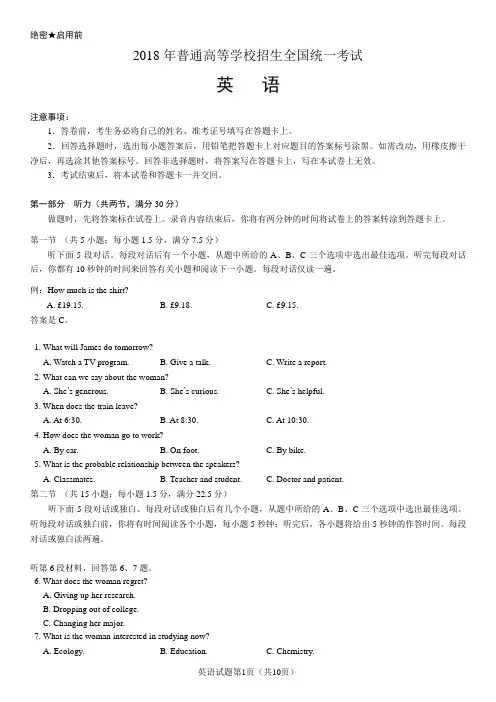
绝密★启用前2018年普通高等学校招生全国统一考试英语注意事项:1.答卷前,考生务必将自己的姓名、准考证号填写在答题卡上。
2.回答选择题时,选出每小题答案后,用铅笔把答题卡上对应题目的答案标号涂黑。
如需改动,用橡皮擦干净后,再选涂其他答案标号。
回答非选择题时,将答案写在答题卡上,写在本试卷上无效。
3.考试结束后,将本试卷和答题卡一并交回。
第一部分听力(共两节,满分30分)做题时,先将答案标在试卷上。
录音内容结束后,你将有两分钟的时间将试卷上的答案转涂到答题卡上。
第一节(共5小题;每小题1.5分,满分7.5分)听下面5段对话。
每段对话后有一个小题,从题中所给的A、B、C三个选项中选出最佳选项。
听完每段对话后,你都有10秒钟的时间来回答有关小题和阅读下一小题。
每段对话仅读一遍。
例:How much is the shirt?A. £19.15.B. £9.18.C. £9.15.答案是C。
1. What will James do tomorrow?A. Watch a TV program.B. Give a talk.C. Write a report.2. What can we say about the woman?A. She’s generous.B. She’s curious.C. She’s helpful.3. When does the train leave?A. At 6:30.B. At 8:30.C. At 10:30.4. How does the woman go to work?A. By car.B. On foot.C. By bike.5. What is the probable relationship between the speakers?A. Classmates.B. Teacher and student.C. Doctor and patient.第二节(共15小题;每小题1.5分,满分22.5分)听下面5段对话或独白。
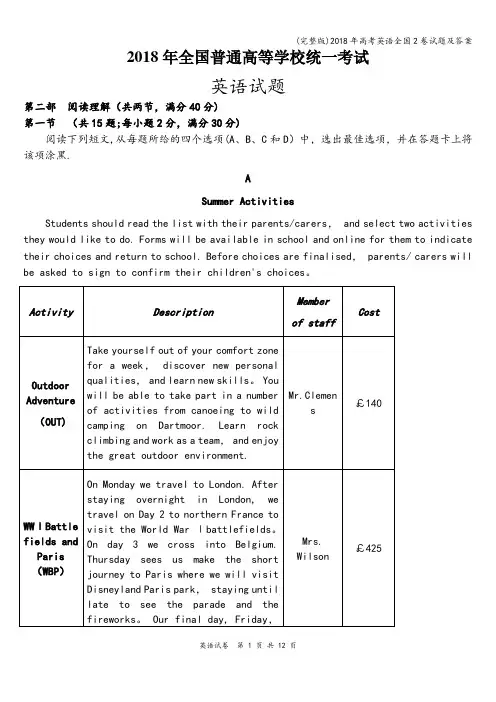
2018年全国普通高等学校统一考试英语试题第二部阅读理解(共两节,满分40分)第一节(共15题;每小题2分,满分30分)阅读下列短文,从每题所给的四个选项(A、B、C和D)中,选出最佳选项,并在答题卡上将该项涂黑.ASummer ActivitiesStudents should read the list with their parents/carers, and select two activities they would like to do. Forms will be available in school and online for them to indicate their choices and return to school. Before choices are finalised, parents/ carers will be asked to sign to confirm their children's choices。
21。
Which activity will you choose if you want to go camping?A。
OUT. B. WBP. C。
CRF. D。
POT。
22。
What will the students do on Tuesday with Mrs. Wilson?A. Travel to LondonB. see a parade and fireworks。
C。
Tour central Paris。
D. Visit the WWI battlefields. 23. How long does Potty about Potter last?A。
Two days. B。
Four days C. Five days D. One week.BM any of us love July because it's the month when nature’s berries and stone fruits are in abundance. These colorful and sweet jewels from British Columbia’s fields are little powerhouses of nutritional protection.Of the common berries, strawberries are highest in vitamin C, although, because of their seeds, raspberries contain a little more protein(蛋白质), iron and zinc (not that fruits have much protein)。
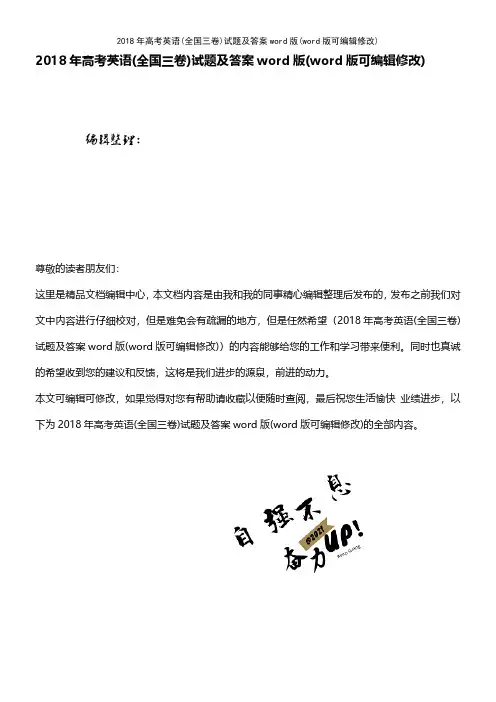
2018年高考英语(全国三卷)试题及答案word版(word版可编辑修改)编辑整理:尊敬的读者朋友们:这里是精品文档编辑中心,本文档内容是由我和我的同事精心编辑整理后发布的,发布之前我们对文中内容进行仔细校对,但是难免会有疏漏的地方,但是任然希望(2018年高考英语(全国三卷)试题及答案word版(word版可编辑修改))的内容能够给您的工作和学习带来便利。
同时也真诚的希望收到您的建议和反馈,这将是我们进步的源泉,前进的动力。
本文可编辑可修改,如果觉得对您有帮助请收藏以便随时查阅,最后祝您生活愉快业绩进步,以下为2018年高考英语(全国三卷)试题及答案word版(word版可编辑修改)的全部内容。
2018年普通高等学校招生全国统一考试英语Ⅲ卷第二部分阅读理解(共两节,满分40分)第一节 (共15小题;每小题2分,满分30分)AWelcome to Holker Hall & GardenVisitor InformationHow to Get to HolkerBy car: Follow brown signs on A590 from. J36, M6. Approximate travel times:Windermere—-20 minutes, Kendal--25 minutes, Lancaster-- 45 minutes, Manchester-— l hour 30minutesBy rail: the nearest station is Cark—in—Cartmel with trains to Carnforth。
Lancaster and Preston for connections to major cities & airports。
Opening timesSunday-Friday(closed on Saturday) 11:00 am—4;00pm, 30 March—2nd November. Admission ChargesHall & Gardens GardensAdults:£12.00 £8。
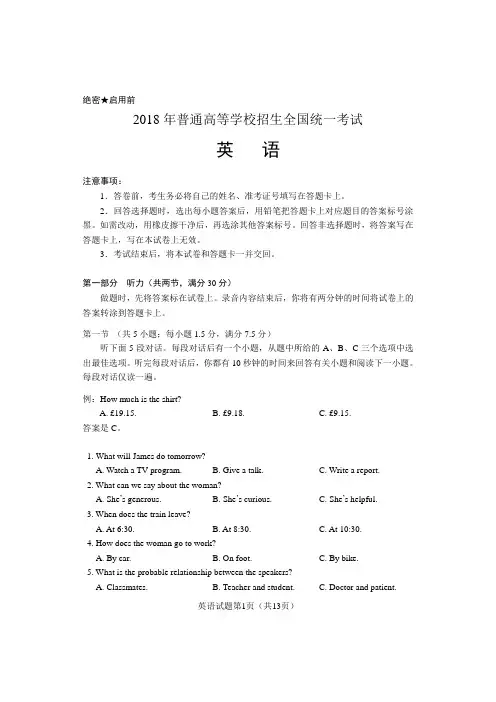
绝密★启用前2018年普通高等学校招生全国统一考试英语注意事项:1.答卷前,考生务必将自己的姓名、准考证号填写在答题卡上。
2.回答选择题时,选出每小题答案后,用铅笔把答题卡上对应题目的答案标号涂黑。
如需改动,用橡皮擦干净后,再选涂其他答案标号。
回答非选择题时,将答案写在答题卡上,写在本试卷上无效。
3.考试结束后,将本试卷和答题卡一并交回。
第一部分听力(共两节,满分30分)做题时,先将答案标在试卷上。
录音内容结束后,你将有两分钟的时间将试卷上的答案转涂到答题卡上。
第一节(共5小题;每小题1.5分,满分7.5分)听下面5段对话。
每段对话后有一个小题,从题中所给的A、B、C三个选项中选出最佳选项。
听完每段对话后,你都有10秒钟的时间来回答有关小题和阅读下一小题。
每段对话仅读一遍。
例:How much is the shirt?A. £19.15.B. £9.18.C. £9.15.答案是C。
1. What will James do tomorrow?A. Watch a TV program.B. Give a talk.C. Write a report.2. What can we say about the woman?A. She’s generous.B. She’s curious.C. She’s helpful.3. When does the train leave?A. At 6:30.B. At 8:30.C. At 10:30.4. How does the woman go to work?A. By car.B. On foot.C. By bike.5. What is the probable relationship between the speakers?A. Classmates.B. Teacher and student.C. Doctor and patient.英语试题第1页(共13页)第二节(共15小题;每小题1.5分,满分22.5分)听下面5段对话或独白。
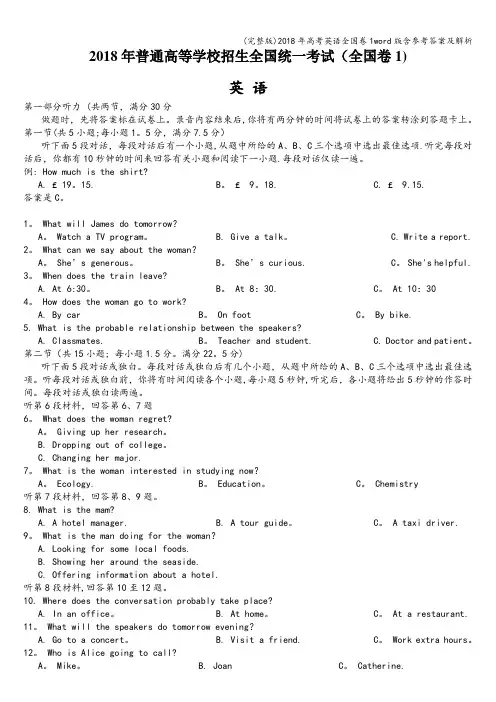
2018年普通高等学校招生全国统一考试(全国卷1)英语第一部分听力 (共两节,满分30分做题时,先将答案标在试卷上。
录音内容结束后,你将有两分钟的时间将试卷上的答案转涂到答题卡上。
第一节(共5小题;每小题1。
5分,满分7.5分)听下面5段对话,每段对话后有一个小题,从题中所给的A、B、C三个选项中选出最佳选项.听完每段对话后,你都有10秒钟的时间来回答有关小题和阅读下一小题.每段对话仅读一遍。
例: How much is the shirt?A. £19。
15. B。
£ 9。
18. C. £ 9.15.答案是C。
1。
What will James do tomorrow?A。
Watch a TV program。
B. Give a talk。
C. Write a report. 2。
What can we say about the woman?A。
She’s generous。
B。
She’s curious.C。
She's helpful. 3。
When does the train leave?A. At 6:30。
B。
At 8:30. C。
At 10:304。
How does the woman go to work?A. By car B。
On foot C。
By bike.5. What is the probable relationship between the speakers?A. Classmates. B。
Teacher and student. C. Doctor and patient。
第二节(共15小题; 每小题1.5分。
满分22。
5分)听下面5段对话或独白。
每段对话或独白后有几个小题,从题中所给的A、B、C三个选项中选出最佳选项。
听每段对话或独白前,你将有时间阅读各个小题,每小题5秒钟,听完后,各小题将给出5秒钟的作答时间。
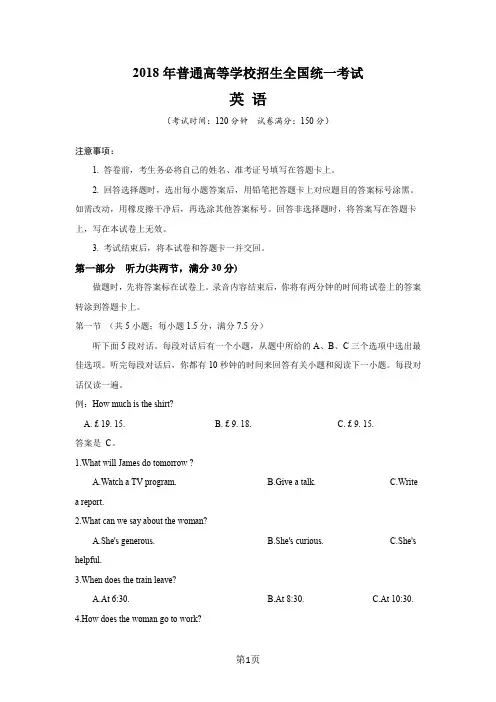
2018年普通高等学校招生全国统一考试英语(考试时间:120分钟试卷满分:150分)注意事项:1. 答卷前,考生务必将自己的姓名、准考证号填写在答题卡上。
2. 回答选择题时,选出每小题答案后,用铅笔把答题卡上对应题目的答案标号涂黑。
如需改动,用橡皮擦干净后,再选涂其他答案标号。
回答非选择题时,将答案写在答题卡上,写在本试卷上无效。
3. 考试结束后,将本试卷和答题卡一并交回。
第一部分听力(共两节,满分30分)做题时,先将答案标在试卷上。
录音内容结束后,你将有两分钟的时间将试卷上的答案转涂到答题卡上。
第一节(共5小题;每小题1.5分,满分7.5分)听下面5段对话。
每段对话后有一个小题,从题中所给的A、B、C三个选项中选出最佳选项。
听完每段对话后,你都有10秒钟的时间来回答有关小题和阅读下一小题。
每段对话仅读一遍。
例:How much is the shirt?A. £ 19. 15.B. £ 9. 18.C. £ 9. 15.答案是C。
1.What will James do tomorrow ?A.Watch a TV program.B.Give a talk.C.Writea report.2.What can we say about the woman?A.She's generous.B.She's curious.C.She's helpful.3.When does the train leave?A.At 6:30.B.At 8:30.C.At 10:30.4.How does the woman go to work?A.By car.B.On foot.C.By bike.5.What is the probable relationship between the speakers?A.Classmates.B.Teacher and student.C.Doctor and patient.第二节(共15小题;每小题1.5分,满分22.5分)听下面5段对话或独白。
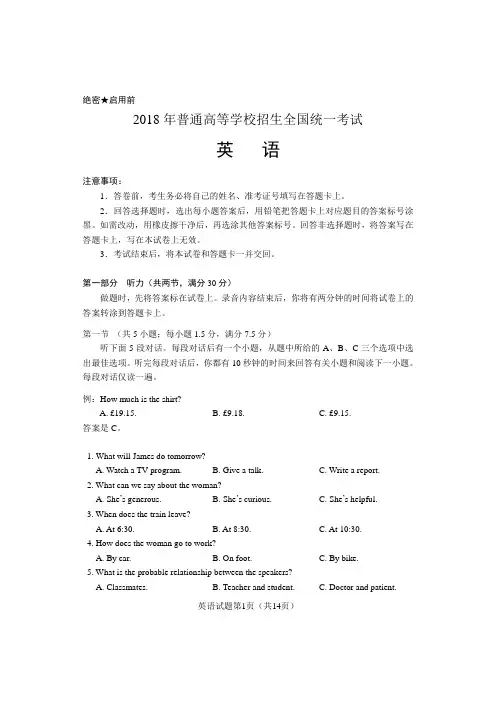
绝密★启用前2018年普通高等学校招生全国统一考试英语注意事项:1.答卷前,考生务必将自己的姓名、准考证号填写在答题卡上。
2.回答选择题时,选出每小题答案后,用铅笔把答题卡上对应题目的答案标号涂黑。
如需改动,用橡皮擦干净后,再选涂其他答案标号。
回答非选择题时,将答案写在答题卡上,写在本试卷上无效。
3.考试结束后,将本试卷和答题卡一并交回。
第一部分听力(共两节,满分30分)做题时,先将答案标在试卷上。
录音内容结束后,你将有两分钟的时间将试卷上的答案转涂到答题卡上。
第一节(共5小题;每小题1.5分,满分7.5分)听下面5段对话。
每段对话后有一个小题,从题中所给的A、B、C三个选项中选出最佳选项。
听完每段对话后,你都有10秒钟的时间来回答有关小题和阅读下一小题。
每段对话仅读一遍。
例:How much is the shirt?A. £19.15.B. £9.18.C. £9.15.答案是C。
1. What will James do tomorrow?A. Watch a TV program.B. Give a talk.C. Write a report.2. What can we say about the woman?A. She’s generous.B. She’s curious.C. She’s helpful.3. When does the train leave?A. At 6:30.B. At 8:30.C. At 10:30.4. How does the woman go to work?A. By car.B. On foot.C. By bike.5. What is the probable relationship between the speakers?A. Classmates.B. Teacher and student.C. Doctor and patient.英语试题第1页(共14页)第二节(共15小题;每小题1.5分,满分22.5分)听下面5段对话或独白。
2018年普通高等学校招生全国统一考试(新课标Ⅰ卷)英 语注意事项:1.答题前,先将自己的姓名、准考证号填写在试题卷和答题卡上,并将准考证号条形码粘贴在答题卡上的指定位置。
2.选择题的作答:每小题选出答案后,用2B 铅笔把答题卡上对应题目的答案标号涂黑,写在试题卷、草稿纸和答题卡上的非答题区域均无效。
3.非选择题的作答:用签字笔直接答在答题卡上对应的答题区域内。
写在试题卷、草稿纸和答题卡上的非答题区域均无效。
4.考试结束后,请将本试题卷和答题卡一并上交。
第一部分 听力(共两节,满分30分)做题时,先将答案标在试卷上。
录音内容结束后,你将有两分钟的时间将试卷上的答案转涂到答题卡上。
第一节 (共5小题;每小题1.5分,满分7.5分)听下面5段对话。
每段对话后有一个小题,从题中所给的A 、B 、C 三个选项中选出最佳选项。
听完每段对话后,你都有10秒钟的时间来回答有关小题和阅读下一小题。
每段对话仅读一遍。
例:How much is the shirt? A. £ 19. 15.B. £ 9. 18.C. £ 9. 15.答案是 C 。
1.what will James do tomorrow ?A.Watch a TV program.B.Give a talk.C.Write areport.2.What can we say about the woman?A.She's generour.B.She's curious.C.She'shelpful.3.When does the traif leave?此卷只装订不密封级 姓名 准考证号 考场号 座位号A.At 6:30.B.At8:30.C.At 10:30.4.How does the wonar sRwr?mA.By car.B.On foot.C.By bike5.What is the probable relationship between the speakers?A.Classmates.B.Teacher and student.C.Doctor and patient.第二节(共15小题;每小题1.5分,满分22.5分)听下面5段对话或独白。
绝密★启用前2018年普通高等学校招生全国统一考试英语(考试时间:120分钟试卷满分:150分)注意事项:1. 答卷前,考生务必将自己的姓名、准考证号填写在答题卡上。
2. 回答选择题时,选出每小题答案后,用铅笔把答题卡上对应题目的答案标号涂黑。
如需改动,用橡皮擦干净后,再选涂其他答案标号。
回答非选择题时,将答案写在答题卡上,写在本试卷上无效。
3. 考试结束后,将本试卷和答题卡一并交回。
第一部分听力(共两节,满分30分)做题时,先将答案标在试卷上。
录音内容结束后,你将有两分钟的时间将试卷上的答案转涂到答题卡上。
第一节(共5小题;每小题1.5分,满分7.5分)听下面5段对话。
每段对话后有一个小题,从题中所给的A、B、C三个选项中选出最佳选项。
听完每段对话后,你都有10秒钟的时间来回答有关小题和阅读下一小题。
每段对话仅读一遍。
例:How much is the shirt?A. £ 19. 15.B. £ 9. 18.C. £ 9. 15.答案是C。
1.what will James do tomorrow ?A.Watch a TV program.B.Give a talk.C.Write a report.2.What can we say about the woman?A.She's generour.B.She's curious.C.She's helpful.3.When does the traif leave?A.At 6:30.B.At8:30.C.At 10:30.4.How does the wonar sRwr?mA.By car.B.On foot.C.By bike5.What is the probable relationship between the speakers?A.Classmates.B.Teacher and student.C.Doctor and patient. 第二节(共15小题;每小题1.5分,满分22.5分)听下面5段对话或独白。
绝密★启用前2018年普通高等学校招生全国统一考试英语(Ⅰ卷)第一部分听力(共两节,满分30分)第一节(共5小题;每小题1.5分,满分7.5分)听下面5段对话。
每段对话后有一个小题,从题中所给的A、B、C三个选项中选出最佳选项。
听完每段对话后,你都有10秒钟的时间来回答有关小题和阅读下一小题。
每段对话仅读一遍。
例:How much is the shirt?A. £19.15.B. £9.18.C. £9.15.答案是C。
1. What will James do tomorrow?A. Watch a TV programB. Give a talk.C. Write a report.2. What can we say about the woman?A. She’s generous.B. She’s curiousC. She’s helpful.3. When does the train leave?A. At 6:30.B. At 8:30.C. At 10:30.4. How does the woman go to work?A. By car.B. On foot.C. By bike.5. What is the probable relationship between the speakers?A. Classmates.B. Teacher and studentC. Doctor and patient.第二节(共15小题;每小题1.5分,满分22.5分)听下面5段对话或独白。
每段对话或独白后有几个小题,从题中所给的A、B、C 三个选项中选出最佳选项。
听每段对话或独白前,你将有时间阅读各个小题,每小题5秒钟;听完后,各小题将给出5秒钟的作答时间。
每段对话或独白读两遍。
听第6段材料,回答第6、7题。
6. What does the woman regret?A. Giving up her research.B. Dropping out of college.C. Changing her major.7. What is the woman interested in studying now?A. Ecology.B. Education.C. Chemistry. 听第7段材料,回答第8、9题。
2018 年一般高等学校招生全国一致考试(全国卷1)英语第一部分听力(共两节,满分30 分做题时,先将答案标在试卷上。
录音内容结束后,你将有两分钟的时间将试卷上的答案转涂到答题卡上。
第一节 (共 5 小题;每题 1.5 分,满分7.5 分 )听下边 5 段对话,每段对话后有一个小题,从题中所给的A、 B、C 三个选项中选出最正确选项。
听完每段对话后,你都有10 秒钟的时间往返答相关小题和阅读下一小题。
每段对话仅读一遍。
例: How much is the shirt?A.£19.15.B.£9.18.C.£9.15.答案是 C。
1.What will James do tomorrow?A. Watch a TV program.B. Give a talk.C. Write a report.2.What can we say about the woman?A. She ’ s generous.B. She ’ s curious.C. She ’ s helpful.3.When does the train leave?A. At 6:30.B. At 8:30.C. At 10:304.How does the woman go to work?A. By carB. On footC. By bike.5.What is the probable relationship between the speakers?A. Classmates.B. Teacher and student.C. Doctor and patient.第二节 (共 15 小题 ; 每题 1.5分。
满分 22.5 分 )听下边 5 段对话或独白。
每段对话或独白后有几个小题,从题中所给的 A 、B、C 三个选项中选出最正确选项。
听每段对话或独白前,你将有时间阅读各个小题,每题 5 秒钟,听完后,各小题将给出 5 秒钟的作答时间。
绝密★启用前2018年普通高等学校招生全国统一考试英语注意事项:1.答卷前,考生务必将自己的姓名、准考证号填写在答题卡上。
2.回答选择题时,选出每小题答案后,用铅笔把答题卡上对应题目的答案标号涂黑。
如需改动,用橡皮擦干净后,再选涂其他答案标号。
回答非选择题时,将答案写在答题卡上,写在本试卷上无效。
3.考试结束后,将本试卷和答题卡一并交回。
第一部分听力(共两节,满分30分)做题时,先将答案标在试卷上。
录音内容结束后,你将有两分钟的时间将试卷上的答案转涂到答题卡上。
第一节(共5小题;每小题1.5分,满分7.5分)听下面5段对话。
每段对话后有一个小题,从题中所给的A、B、C三个选项中选出最佳选项。
听完每段对话后,你都有10秒钟的时间来回答有关小题和阅读下一小题。
每段对话仅读一遍。
例:How much is the shirt?A. £19.15.B. £9.18.C. £9.15.答案是C。
1. What will James do tomorrow?A. Watch a TV program.B. Give a talk.C. Write a report.2. What can we say about the woman?A. She’s generous.B. She’s curious.C. She’s helpful.3. When does the train leave?A. At 6:30.B. At 8:30.C. At 10:30.4. How does the woman go to work?A. By car.B. On foot.C. By bike.5. What is the probable relationship between the speakers?A. Classmates.B. Teacher and student.C. Doctor and patient.第二节(共15小题;每小题1.5分,满分22.5分)听下面5段对话或独白。
绝密★启用前2018年普通高等学校招生全国统一考试英语试题及答案(考试时间:120分钟试卷满分:150分)注意事项:1. 答卷前,考生务必将自己的姓名、准考证号填写在答题卡上。
2. 回答选择题时,选出每小题答案后,用铅笔把答题卡上对应题目的答案标号涂黑。
如需改动,用橡皮擦干净后,再选涂其他答案标号。
回答非选择题时,将答案写在答题卡上,写在本试卷上无效。
3. 考试结束后,将本试卷和答题卡一并交回。
第一部分听力(共两节,满分30分)做题时,先将答案标在试卷上。
录音内容结束后,你将有两分钟的时间将试卷上的答案转涂到答题卡上。
第一节(共5小题;每小题1.5分,满分7.5分)听下面5段对话。
每段对话后有一个小题,从题中所给的A、B、C三个选项中选出最佳选项。
听完每段对话后,你都有10秒钟的时间来回答有关小题和阅读下一小题。
每段对话仅读一遍。
例:How much is the shirt?A. £19. 15.B. £9. 18.C. £9. 15.C。
答案是1.what will James do tomorrow ?C.Write a report.B.Give a talk. A.Watch a TV program.2.What can we say about the woman?A.She's generour.B.She's curious.C.She's helpful.3.When does the traif leave?A.At 6:30.B.At8:30.C.At 10:30.4.How does the wonar sRwr?mA.By car.B.On foot.C.By bike5.What is the probable relationship between the speakers?A.Classmates.B.Teacher and student.C.Doctor and patient.1第二节(共15小题;每小题1.5分,满分22.5分)听下面5段对话或独白。
每段对话或独白后有几个小题,从题中所给的A、B、C三个选项中选出最佳选项。
听每段对话或独白前,你将有时间阅读各个小题,每小题5秒钟;听完后,各小题将给出5秒钟的作答时间。
每段对话或独白读两遍。
听第6段材料,回答第6、7题。
6.What does the woman regret?A.Giving up her research.B.Dropping out of college.C.Changiny her major.7.What is the woman interested in studying now?A.Ecology.cation.C.Chemistry.9题。
听第7段材料,回答第8、8.What is the man?C.A taxi driver.B.A tour guide.A.A hotel manager.9.what is the man doing for the woman?A.looking for some local foods.B.Showing her around the seaside.C.Offering information about a hotel.12题。
10听第8段材料,回答第至10.Where does the conversation probably take place?C.At a restaurant.B.At homeA.In an office.11.What will the speakers do tomorow evening?C.work extra hours.A.Goto a concert.B.Visit a friend12.Who is Alice going to call?C.Catherine .A.Mike .B.Joan听第9至1316题。
段材料,回答第13.why does the woman meet the man?A.To look at an apartment.B.To deliver some furniture.C.To have a meal together.214.What does the woman like about the carpet?A.Its color.B.Its design.C. Its quality .15.What does the man say about the kitchen?A.It's a good size.B.It's newly painted.C. It's adequately equipped .16.What will the woman probably do next?A.Go downtown.B.Talk with her friend.C.Make payment .听第10段材料,回答第17至20题。
17.Who is the speaker probably talking to?A.Movie fans .B.News reporters.C.College students .18.When did the speaker take Engishlclasses? wwnA.Before he left his hometown.B.After he came to America.C.When he was 15 years old.19.How does the speaker feel about his teacher?A.He's proud.B.He's sympathetic.C.He's grateful .20.What does the speaker mainly talk about ?A.How education shaped his life.B.How his language skills improved.C.How he managed his business well.第二部分阅读理解(共两节,满分40分)第一节(共15小题;每小题2分,满分30分)阅读下列短文,从每题所给的A、B、C和D四个选项中,选出最佳选项。
AWashington, D.C. Bicycle ToursCherry Blossom Bike Tour in Washington, D.C.Duration TourThis small group bike tour is a fantastic way to see a world-famous cherry trees with beautiful flowers ofWashington, D.C. Your guide will provide a history lesson about the trees and the famous monuments where theyblossom. Reserve your spot before availability —the cherry blossoms—disappear!Washington Capital Monuments Bicycle Tour3Duration:3 hours (4 miles)Join a guided bike tour and view some of the most popular monuments in Washington, D.C. Explore themonuments and memorials on the National Mall as your guide shares unique facts and history at each stop. Guidedtour includes bike, helmet, cookies and bottled water.Capital City Bike Tour In Washington, D.C.Duration:3 hoursMorning or Afternoon, this bike tour is the perfect tour for D. C. newcomers and locals looking to experienceWashington, D.C. in a healthy way with minimum effort. Knowledgeable guides will entertain you with themost ,interesting stories about Presidents, Congress, memorials, and parks. Comfortable bikes and a smooth tourroute(路线)make cycling between the sites fun and relaxing.z.xxkWashington Capital Sites at Night Bicycle TourDuration:3 hours(7miles)Join a small group bike tour for an evening of exploration in the heart of Washington, D.C. Get up close to themonuments and memorials as your bike the sites of Capitol Hill and the National Mall. Frequent stops are made forphoto taking as your guide offers unique facts and history. Tour includes bike, helmet, and bottled water. All ridersare equipped with reflective vests and safety lights.21.Whichtour do you need to book in advance?A. Cherry Blossom like Tour in Washington, D.C.B. Washington capital Monuments Bicycle Tour.C. Capital City Bike Tour in Washington,D.C.D. Washington Capital Sites at Night Bicycle Tour.22.What will you do on the Capital City Bike Tour?A. Meet famous people.B. Go to a national park.D. Enjoy interesting stories.C. Visit well-known museums.23.Which of the following does the bicycle tour at night provide?A. City maps.B. Cameras.C. MealsD. Safety lightsBGood Morning Britain's Susanna Reid is used to grilling guests on the sofa every morning, but she is cooking4up a storm in her latest role —showing families how to prepare delicious and nutritious meals on a tight budget.In Save Money: Good Food, she visits a different home each week and with the help of chef Matt Tebbuttoffers top tips on how to reduce food waste, while preparing recipes for under £5 per family a day. And the GoodMorning Britain presenter says she's been able to put a lot of what she's leant into practice in her own home,preparing meals for sons, Sam,14, Finn,13, and Jack, 11.We love Mexican churros, so I buy them on my phone from my local Mexican takeaway restaurant, she explains. I pay £5 for a portion(一份), but Matt makes them for 26p a portion, because they are flour, water, sugarand oil. Everybody can buy takeaway food, but sometimes we're not aware how cheaply we can make this foodourselves.The eight-part series(系列节自), Save Money: Good Food, follows in the footsteps of ITV's SaveMoney:Good Health, which gave viewers advice on how to get value from the vast range of health products on the market.With food our biggest weekly household expense, Susanna and Matt spend time with a different family eachweek. In tonight's Easter special they come to the aid of a family in need of some delicious inspiration on a budget.The team transforms the family's long weekend of celebration with less expensive but still tasty recipes.24. What do we know about Susanna Reid?A. She enjoys embarrassing her guests.B. She has started a new programme.D. She has had a light budget for her family.C. She dislikes working early in the morning.25. How does Matt Tebbutt help Susanna?A. He buys cooking materials for her.B. He prepares food for her kids.D. He invites guest families for her.C. He assists her in cooking matters.26. What does the author intend to do in paragraph 4?A. Summarize the previous paragraphs.B. Provide some advice for the readers.D. Introduce a new topic for discussion.C. Add some background information.27. What can be a suitable title for the text?A. Keeping Fit by Eating SmartB. Balancing Our Daily DietD. Cooking Well for LessC. Making yourself a Perfect ChefCLanguages have been coming and going for thousands of years, but in recent times there has been less coming)groups and a lot more going. When the the world was still populated by hunter-gatherers,small, tightly knit (联系developed their own patterns of speech independent of each other.Some language experts believe that 10,000 years5ago, when the world had just five to ten million people, they spoke perhaps 12,000 languages between them.Soon afterwards, many of those people started settling down to become farmers, and their languages toobecame more settled and fewer in number. In recent centres, trade,industrialisation. the development of thenation-state and the spread of universal compulsory education. Especially glbalisation and better communicationsin the past few decades,all have caused many Languages to disappear,and dominant languages such asEnglish.Spanish and Chinese are increasingly taking over.At present, the world has about 6 800 languages. The distribution of these languages is hugely uneven. Thegeneral rule is that mild zones have relatively few languages. Often spoken by many people while hot. wet zoneshave lots, often spoken by small numbers.Europe has only around 200 Languages: the Americas about 1,000. Africa2 400; and Asia and the Pacific perhaps 3,200, of which Papua New Guinea alone accounts for well over 800. Themedian number (中位数)of speakers is a mere 6.000, which means that half the worlds languages are spoken byfewer people than that.z.x.xkAlready well over 400 of the total of, 6,800 languages are close to extinction(消亡), with only a few elderlyspeakers left. Pick, at random, Busuu in Cameroon (eight remaining speakers),Chiapaneco in Mexico(150). LipanApache in the United States(two or three)or Wadjigu in Australia (one, with a question-mark): none of these seemsto have much chance of survival.28. What can we infer about languages in huntergatherer times?A.They developed very fast.B. They were large in number.C. They had similar patters.D. They were closely connected29. Which of the following best explainsdominant underlined in paragraph 2?plex.B. Advanced.C.Powerful.D.Modem.30. How many languages are spoken by less than 6, 000 people at present?A.About 6 800B.About 3 400C.About 2.400D.About 1-20031. What is the min idea of the text?A. New languages will be created.B Peoples lifestyles are reflected in languagesC. Human development results in fewer languagesD. Geography determines language evolution.6DWe may think we're a culture that gets rid of our worn technology at the first sight of something shiny and new,but a new study shows that we keep using our old devices(装置) well after they go out of style. That's bad news forthe environment —and our wallets —as these outdated devices consume much more energy than the newer onesthat do the same things.To figure out how much power these devices are using, Callie Babbitt and her colleagues at theRochesterInstitute of Technology in New York tracked the environmental costs for each product throughout its life —fromwhen its minerals are mined to when we stop using the device. This method provided a readout for how homeenergy use has evolved since the early 1990s. Devices were grouped by generation —Desktop computers, basicmobile phones, and box-set TVs defined 1992. Digital cameras arrived on the scene in 1997. And MP3 players,smart phones, and LCD TVs entered homes in 2002, before tablets and e-readers showed up in 2007. As we accumulated more devices, however, we didn't throw out our old ones. The living-room television isreplaced and gets planted in the kids' room, and suddenly one day, you have a TV in every room of the house, saidone researcher. The average number of electronic devices rose from four per household in 1992 to 13 in 2007.We're not just keeping these old devices —we continue to use them. According to the analysis of Babbitt's team,old desktop monitors and box TVs with cathode ray tubes are the worst devices with their energy consumption andcontribution to greenhouse gas emissions(排放)more than doubling during the 1992 to 2007 window. So what's the solution(解决方案)? The team's data only went up to 2007, but the researchers also exploredwhat would happen if consumers replaced old products with new electronics that serve more than one function,such as a tablet for word processing and TV viewing. They found that more on-demand entertainment viewing ontablets instead of TVs and desktop computers could cut energy consumption by 44%.32. What does the author think of new devices?A. They are environment-friendly.B. They are no better than the old.D. They go out of style quickly.C. They cost more to use at home.33. Why did Babbitt's team conduct the research?A. To reduce the cost of minerals.B. To test the life cycle of a product.C. To update consumers on new technology.D. To find out electricity consumption of the devices.34. Which of the following uses the least energy?7A. The box-set TV.B. The tablet.D. The desktop computer.C. The LCD TV.35. What does the text suggest people do about old electronic devices?A. Stop using them.B. Take them apart.D. Recycle them.C. Upgrade them.) 小题;每小题第二节(共52分,满分10分根据短文内容,从短文后的选项中选出能填入空白处的最佳选项。